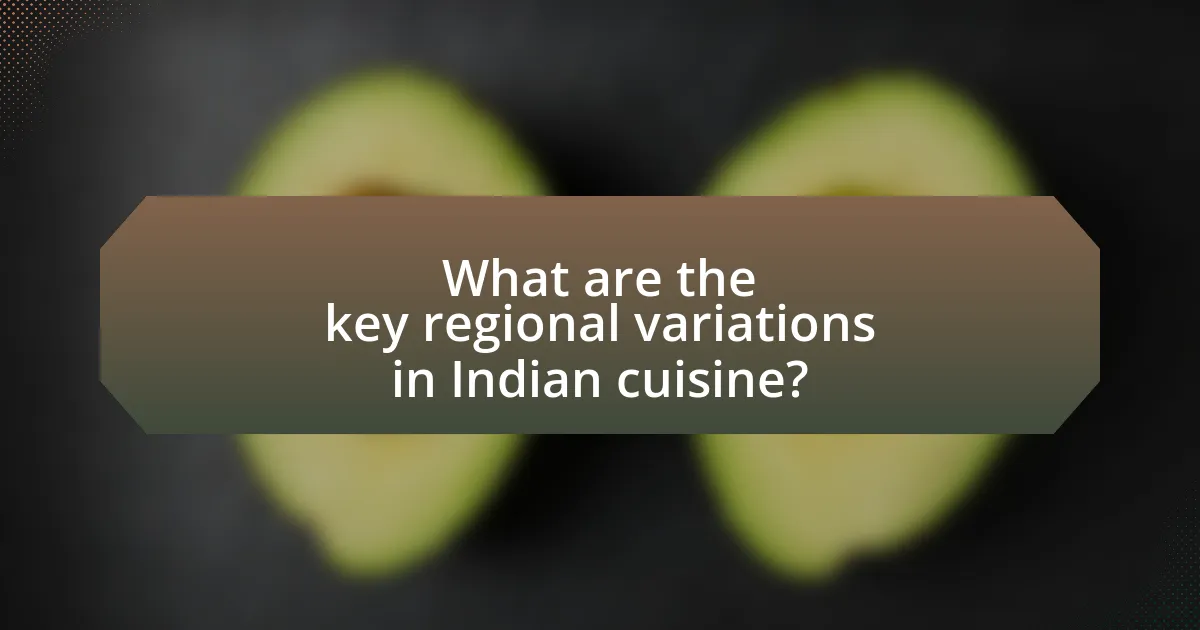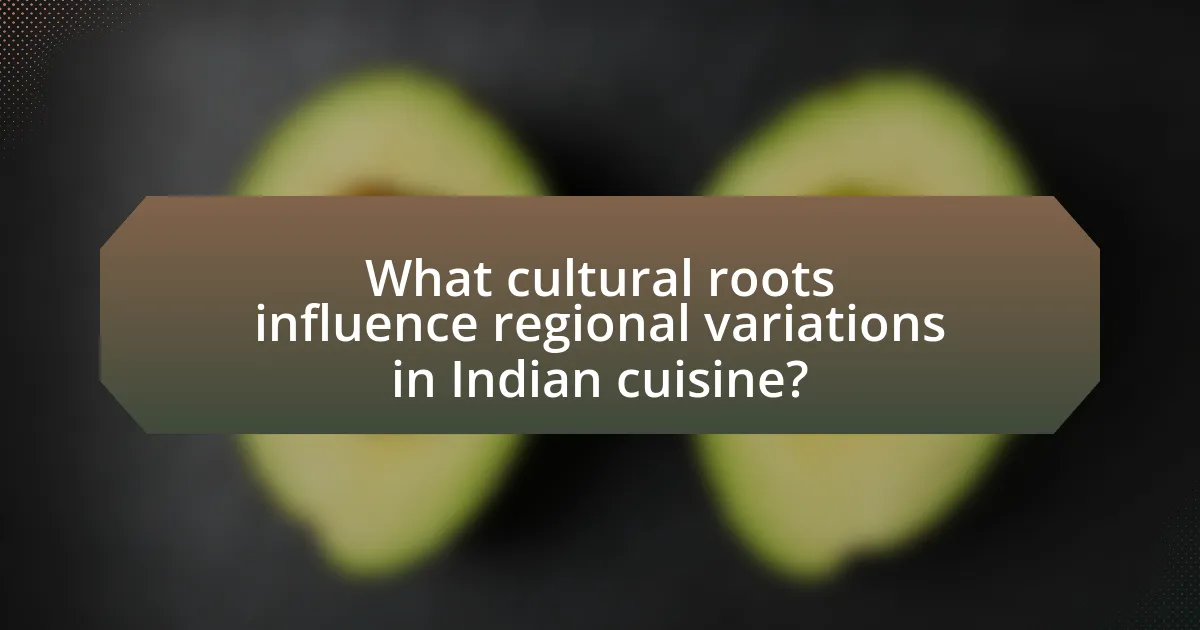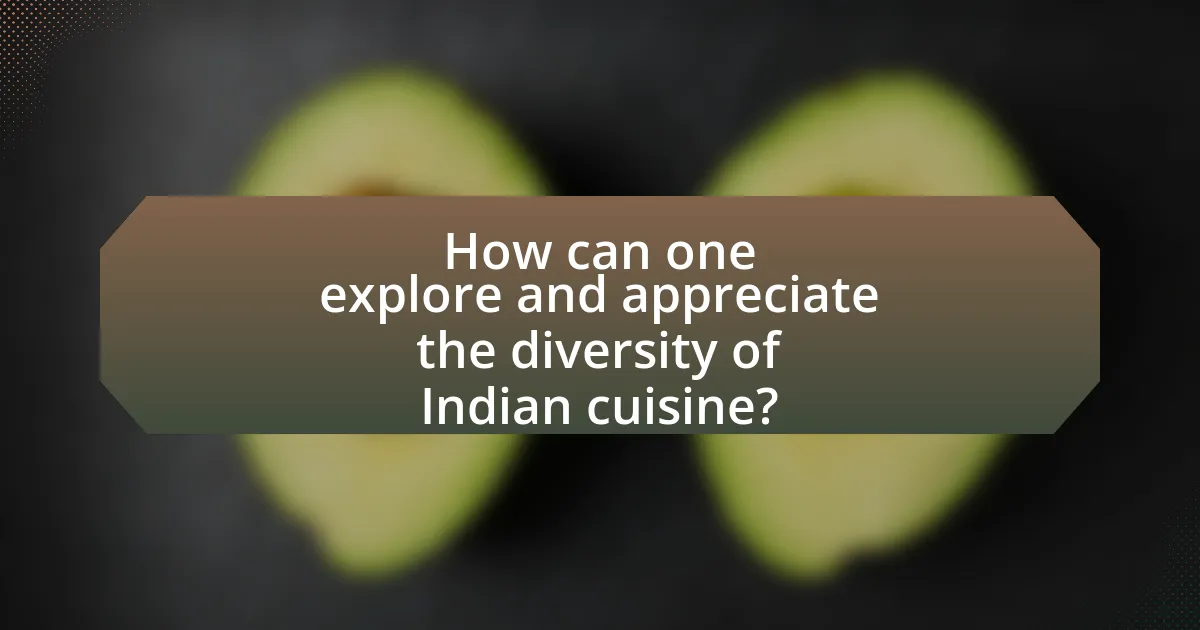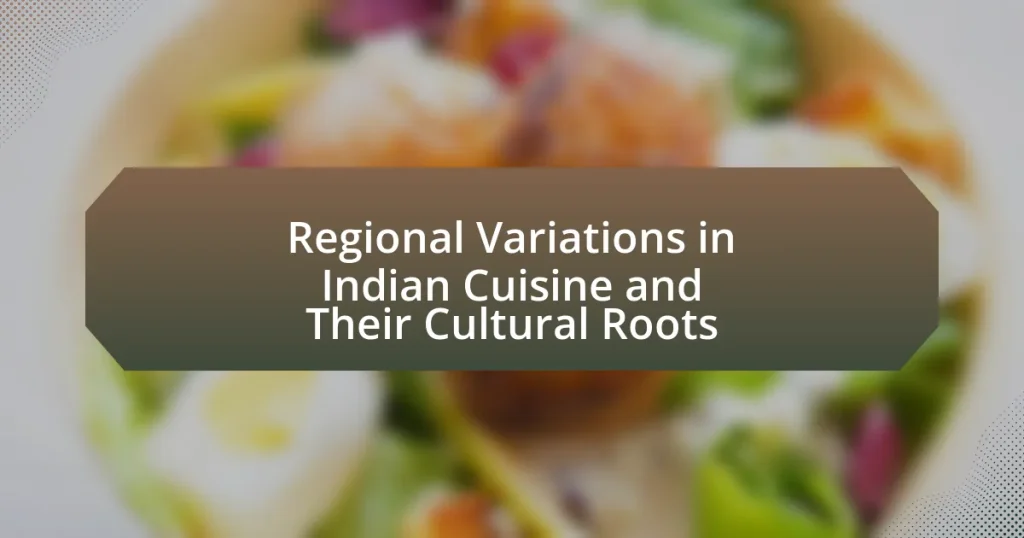The article focuses on the regional variations in Indian cuisine and their cultural roots, highlighting how geography, climate, and historical influences shape diverse culinary practices across the country. It details the distinct characteristics of North, South, East, and West Indian cuisines, emphasizing the role of local ingredients, agricultural practices, and religious beliefs in defining cooking styles. Additionally, the article explores the impact of historical events, trade routes, and migrations on regional flavors, while providing insights into traditional food customs associated with festivals and tips for experiencing authentic regional dishes. Overall, it underscores the rich tapestry of flavors and techniques that characterize Indian cuisine, reflecting its cultural heritage.

What are the key regional variations in Indian cuisine?
Indian cuisine exhibits significant regional variations influenced by geography, climate, and cultural practices. Northern Indian cuisine is characterized by rich, creamy dishes like butter chicken and paneer tikka, often using dairy and wheat. In contrast, Southern Indian cuisine features rice as a staple, with dishes like dosa and sambar, emphasizing spices and coconut. Eastern Indian cuisine, particularly from Bengal, is known for its fish dishes and sweets like rasgulla, while Western Indian cuisine includes diverse offerings such as the spicy curries of Gujarat and the seafood of Maharashtra. These variations reflect local ingredients, traditions, and historical influences, showcasing India’s culinary diversity.
How do geographical factors influence Indian culinary diversity?
Geographical factors significantly influence Indian culinary diversity by determining the availability of local ingredients, climate conditions, and cultural interactions. For instance, coastal regions like Kerala and Goa utilize seafood extensively due to their proximity to the ocean, while arid regions like Rajasthan rely on grains and legumes that can withstand dry conditions. Additionally, the diverse climates across India—from the tropical south to the temperate north—affect the types of crops grown, leading to variations in staple foods such as rice, wheat, and millet. Historical trade routes and migrations have also introduced spices and cooking techniques, further enriching regional cuisines. For example, the use of coconut in South Indian dishes reflects both local agriculture and cultural exchanges with Southeast Asia.
What role do climate and agriculture play in shaping regional dishes?
Climate and agriculture significantly influence regional dishes by determining the types of crops that can be cultivated and the ingredients available for cooking. For instance, in India, the tropical climate of the southern regions supports rice cultivation, leading to rice-based dishes like dosa and idli, while the arid climate of the northwest favors wheat, resulting in bread-based dishes such as roti and paratha. Additionally, agricultural practices, such as the use of spices and herbs, are shaped by local climate conditions, enhancing the flavor profiles of regional cuisines. Historical data shows that regions with abundant rainfall produce diverse vegetables and fruits, which are integral to local recipes, while drier areas rely on preserved foods and grains. Thus, the interplay between climate and agriculture is crucial in defining the culinary landscape of different regions.
How does the availability of local ingredients affect cooking styles?
The availability of local ingredients significantly influences cooking styles by shaping the flavors, techniques, and dishes that are prevalent in a region. In Indian cuisine, for example, the use of locally sourced spices, vegetables, and grains leads to distinct regional dishes that reflect the agricultural practices and climate of the area. For instance, coastal regions utilize seafood and coconut, while northern regions favor dairy and wheat-based dishes. This reliance on local ingredients not only enhances the authenticity of the cuisine but also promotes sustainability and supports local economies. Historical evidence shows that traditional Indian cooking has evolved based on the ingredients available in specific regions, leading to diverse culinary practices across the country.
What are the major regional cuisines of India?
The major regional cuisines of India include North Indian, South Indian, East Indian, and West Indian cuisines. North Indian cuisine is characterized by its use of dairy products, wheat, and rich gravies, with popular dishes like butter chicken and naan. South Indian cuisine features rice, lentils, and coconut, with staples such as dosa and sambar. East Indian cuisine is known for its fish and rice dishes, with specialties like macher jhol and pitha. West Indian cuisine varies significantly, with Gujarat focusing on vegetarian dishes, Maharashtra offering a mix of vegetarian and seafood, and Rajasthan known for its spicy and rich flavors. Each regional cuisine reflects the local ingredients, climate, and cultural influences, showcasing India’s diverse culinary heritage.
What distinguishes North Indian cuisine from South Indian cuisine?
North Indian cuisine is distinguished from South Indian cuisine primarily by its use of dairy products, wheat-based staples, and a variety of spices. In North India, dishes often feature ingredients like paneer, yogurt, and ghee, with staples such as roti and naan made from wheat. In contrast, South Indian cuisine predominantly utilizes rice as a staple, along with coconut and lentils, and is characterized by dishes like dosa and idli. The regional climate and agricultural practices also influence these culinary differences; for example, the cooler climate in the North supports wheat cultivation, while the warmer South is conducive to rice farming.
How do East and West Indian cuisines differ in flavors and techniques?
East and West Indian cuisines differ significantly in flavors and techniques, primarily due to regional ingredients and cultural influences. East Indian cuisine, particularly from states like West Bengal and Odisha, emphasizes the use of mustard oil, fish, and a variety of spices such as panch phoron, leading to a flavor profile that is often lighter and more aromatic. In contrast, West Indian cuisine, especially from Gujarat and Maharashtra, incorporates a diverse range of spices like cumin and coriander, often resulting in richer, spicier dishes that may include ingredients like coconut and jaggery.
Techniques also vary; East Indian cooking often involves steaming and slow cooking, while West Indian methods include frying and grilling. These differences are rooted in the geographical availability of ingredients and historical trade influences, such as the impact of Portuguese cuisine in the West.

What cultural roots influence regional variations in Indian cuisine?
Regional variations in Indian cuisine are influenced by diverse cultural roots, including historical migrations, religious practices, and local agricultural practices. For instance, the influence of Mughal cuisine is prominent in North India, characterized by rich gravies and the use of spices like saffron and cardamom, stemming from the Mughal Empire’s historical presence. In contrast, South Indian cuisine reflects the agricultural abundance of rice and coconut, with dishes like dosa and sambar, shaped by local ingredients and traditions. Additionally, the impact of various religious communities, such as Hindu vegetarianism and Islamic dietary laws, further diversifies the culinary landscape across regions. These cultural roots collectively contribute to the rich tapestry of flavors and cooking techniques found in Indian cuisine.
How do historical events shape culinary practices in different regions?
Historical events significantly shape culinary practices in different regions by influencing the availability of ingredients, cooking techniques, and cultural exchanges. For instance, the Mughal Empire’s rule in India introduced rich spices, dairy, and meat dishes, which transformed North Indian cuisine, leading to the creation of dishes like biryani and kebabs. Additionally, colonialism brought new ingredients such as potatoes and tomatoes, which were integrated into local cuisines, altering traditional recipes and cooking methods. The migration of communities, such as the Parsis and Jews, also contributed unique culinary elements, further diversifying regional practices. These historical influences demonstrate how past events directly impact the evolution of culinary traditions in specific areas.
What impact did trade routes have on the evolution of Indian cuisine?
Trade routes significantly influenced the evolution of Indian cuisine by facilitating the exchange of ingredients, cooking techniques, and culinary traditions. Historical trade routes, such as the Silk Road and maritime routes, introduced spices like black pepper, cardamom, and saffron from different regions, which became integral to Indian cooking. Additionally, the arrival of new foods, such as tomatoes, potatoes, and chilies from the Americas during the Columbian Exchange, transformed traditional dishes and expanded the flavor profile of Indian cuisine. This blending of diverse culinary elements led to regional variations, reflecting the cultural interactions and adaptations that occurred through trade.
How have migrations and invasions influenced regional flavors?
Migrations and invasions have significantly influenced regional flavors by introducing new ingredients, cooking techniques, and culinary traditions. For instance, the arrival of the Mughals in India brought Persian influences, leading to the incorporation of spices like saffron and cooking methods such as dum (slow cooking). Similarly, the British colonial period introduced ingredients like potatoes and tomatoes, which became staples in Indian cuisine. Historical records indicate that the movement of traders and conquerors, such as the Portuguese, also introduced ingredients like chili peppers and cashews, which are now integral to various regional dishes. These interactions have created a rich tapestry of flavors that reflect the diverse cultural influences throughout India’s history.
What role do religious beliefs play in regional cooking styles?
Religious beliefs significantly influence regional cooking styles by dictating dietary restrictions, ingredient preferences, and cooking methods. For instance, Hinduism promotes vegetarianism, leading to a prevalence of plant-based dishes in regions like Gujarat, where meat consumption is minimal. In contrast, Islamic dietary laws, such as halal practices, shape the culinary landscape in areas like Hyderabad, where meat dishes are prominent and prepared according to specific guidelines. Additionally, festivals and rituals tied to religious observances often dictate special dishes, further diversifying regional cuisines. This interplay between religion and food is evident in the diverse offerings across India, reflecting the cultural roots and beliefs of its communities.
How do vegetarian and non-vegetarian practices vary across regions?
Vegetarian and non-vegetarian practices vary significantly across regions, particularly in India, where cultural, religious, and geographical factors influence dietary choices. In states like Gujarat and Rajasthan, vegetarianism is predominant due to strong Jain and Hindu influences, with approximately 70% of the population adhering to vegetarian diets. Conversely, in coastal regions such as Kerala and West Bengal, non-vegetarian diets are prevalent, with seafood and meat being integral to local cuisine, reflecting the availability of resources and cultural traditions. This regional disparity is further supported by the 2019 report from the Food and Agriculture Organization, which highlights that dietary habits in India are shaped by a combination of religious beliefs, local agriculture, and historical practices.
What are the traditional food customs associated with festivals in different regions?
Traditional food customs associated with festivals in different regions of India vary significantly, reflecting the diverse cultural heritage of the country. For instance, in Punjab, during the festival of Lohri, people celebrate with foods like sesame seeds, jaggery, and a special dish called ‘makki di roti’ served with ‘sarson da saag.’ In West Bengal, during Durga Puja, the traditional offerings include ‘bhog’ which consists of rice, lentils, and various sweets like ‘sandesh’ and ‘rasgulla.’ In South India, during Pongal, a dish made of rice and lentils, flavored with ghee and jaggery, is prepared to celebrate the harvest. Each of these customs is deeply rooted in local agricultural practices and religious beliefs, showcasing the importance of food in cultural celebrations across different regions.

How can one explore and appreciate the diversity of Indian cuisine?
One can explore and appreciate the diversity of Indian cuisine by engaging in regional culinary experiences, such as participating in cooking classes, visiting local markets, and dining at authentic restaurants that specialize in specific regional dishes. Indian cuisine is characterized by its vast array of flavors, ingredients, and cooking techniques, which vary significantly across different states and communities. For instance, the use of spices in South Indian dishes differs from the rich gravies of North Indian cuisine, reflecting the cultural and agricultural diversity of the regions. Additionally, understanding the historical context, such as the influence of trade routes and colonialism on regional ingredients and cooking methods, enhances appreciation. Engaging with local chefs and food historians can provide deeper insights into the cultural roots that shape these culinary traditions.
What are some tips for experiencing regional Indian cuisine authentically?
To experience regional Indian cuisine authentically, immerse yourself in local food culture by dining at family-run eateries and street food stalls. These establishments often serve traditional dishes prepared using age-old recipes and local ingredients, reflecting the true flavors of the region. For instance, in Punjab, savoring butter chicken at a dhaba provides insight into the region’s rich culinary heritage. Additionally, participating in cooking classes led by local chefs can enhance your understanding of regional cooking techniques and ingredients, such as the use of spices in South Indian cuisine. Engaging with local markets to source fresh produce and spices also deepens your appreciation for the culinary diversity found across India.
How can one find local eateries that serve traditional dishes?
To find local eateries that serve traditional dishes, one can utilize online platforms such as Google Maps, Yelp, or TripAdvisor, which provide user reviews and ratings specifically for restaurants. These platforms often categorize eateries by cuisine type, allowing users to filter results for traditional dishes specific to a region. Additionally, local food blogs and social media groups focused on regional cuisine can offer recommendations and insights into authentic dining experiences. Research indicates that 70% of diners rely on online reviews to discover new restaurants, highlighting the effectiveness of these tools in locating traditional eateries.
What are some recommended dishes to try from each region?
Recommended dishes to try from each region of India include:
- North India: Butter Chicken, a creamy tomato-based curry, is a staple in Punjabi cuisine, showcasing the region’s rich use of dairy and spices.
- South India: Dosa, a fermented rice and lentil crepe, is popular in Tamil Nadu and reflects the region’s emphasis on rice and lentils.
- East India: Fish Curry, particularly the Bengali style with mustard oil and spices, highlights the coastal resources and culinary traditions of West Bengal.
- West India: Pav Bhaji, a spiced vegetable mash served with bread, is a street food favorite in Maharashtra, illustrating the region’s vibrant street food culture.
- Central India: Biryani, especially the Hyderabadi version, combines rice and meat with aromatic spices, showcasing the Mughal influence in the region.
These dishes exemplify the diverse ingredients and cooking techniques that characterize Indian regional cuisines.
How can understanding cultural roots enhance the appreciation of Indian cuisine?
Understanding cultural roots enhances the appreciation of Indian cuisine by providing context to its diverse flavors, ingredients, and cooking techniques. Indian cuisine is deeply influenced by historical events, regional geography, and cultural practices, which shape its unique characteristics. For instance, the use of spices in Indian cooking can be traced back to ancient trade routes, where spices were not only valued for their flavor but also for their medicinal properties. Additionally, regional variations, such as the use of coconut in South Indian dishes versus mustard oil in North Indian cuisine, reflect local agricultural practices and cultural preferences. This knowledge allows individuals to connect more meaningfully with the food, recognizing it as a reflection of the rich tapestry of Indian history and society.
What resources are available for learning about regional cooking techniques?
Books, online courses, and cooking workshops are valuable resources for learning about regional cooking techniques. Notable books include “Indian Regional Cooking” by Raghavan Iyer, which provides insights into various regional cuisines and their unique methods. Online platforms like MasterClass and Udemy offer courses specifically focused on Indian cooking techniques, allowing learners to explore diverse culinary practices from different regions. Additionally, local cooking workshops often feature chefs who specialize in regional cuisines, providing hands-on experience and authentic knowledge. These resources collectively enhance understanding of the cultural roots and techniques inherent in regional Indian cooking.
How can one incorporate regional Indian flavors into everyday cooking?
To incorporate regional Indian flavors into everyday cooking, one can utilize specific spices, cooking techniques, and traditional recipes from various Indian states. For example, using mustard oil and panch phoron (a five-spice blend) can bring the essence of Bengali cuisine into dishes, while incorporating coconut and curry leaves can infuse South Indian flavors. Additionally, adopting the use of local ingredients such as millet in Rajasthan or fresh herbs like coriander in Maharashtra can enhance authenticity. This approach not only diversifies meals but also connects the cook to the rich cultural heritage of Indian cuisine, which is characterized by its regional diversity and unique flavor profiles.
